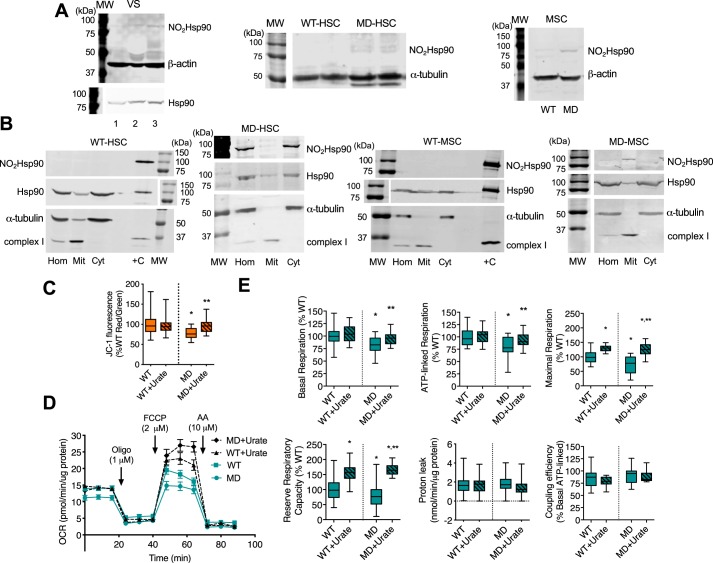Figure 3.
Peroxynitrite selectively down-regulates mitochondrial metabolism in human MD-Schwann cells. A, representative IR Western blots of nitrated and total Hsp90 in homogenates of vestibular schwannomas from three NF2 patients (VS 1 to 3), and human (HSC) and mouse (MSC) WT- and MD-Schwann cells (n = 3–4); and B, in homogenates (Hom) and mitochondrial (Mit) and cytosolic (Cyt) fractions of human and mouse WT- and MD-Schwann cells subjected to subcellular fractionation (n = 3). +C: positive control, nitrated recombinant Hsp90. C, the mitochondrial membrane potential of human WT- and MD-Schwan cells after 48 h incubation in the absence or presence of urate (100 μm) was determined after incubation of the cells with the probe JC-1 (5 μm) for 30 min and expressed as the percentage of the ratio of red over green JC-1 fluorescence (n = 3 with 8 replicates). *, p < 0.05 versus untreated WT; **, versus untreated MD by Kruskal-Wallis test. D, the OCR of human WT- and MD-Schwann cells after 48 h of incubation in the absence and presence of urate (100 μm) was measured by extracellular flux analysis in basal conditions and after the sequential addition of oligomycin (1 μm, oligo), FCCP (2 μm), and antimycin A (10 μm, AA) (mean ± S.E. of 5 independent experiments with 5 replicates). E, analysis of the different OCR parameters after sequential addition of the inhibitors, expressed as percentage of WT-Schwann cells (n = 5 with 5 replicates). *, p < 0.001 versus untreated WT-Schwann cells; **, versus untreated MD-Schwann cells by one-way ANOVA followed by Bonferroni post test.

